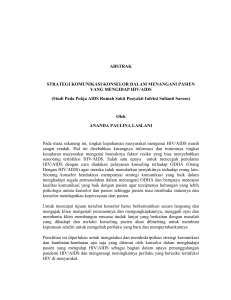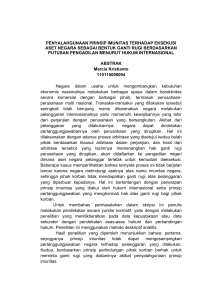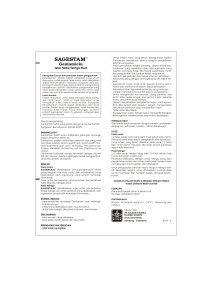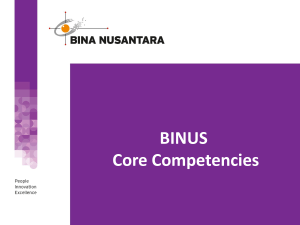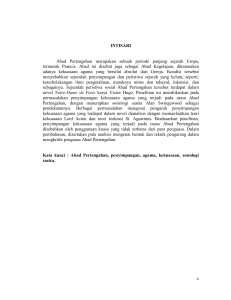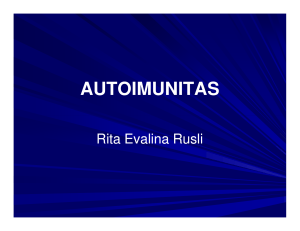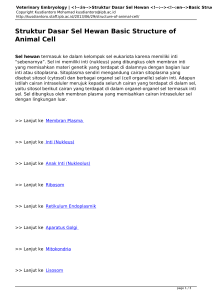CUCI PBS
advertisement
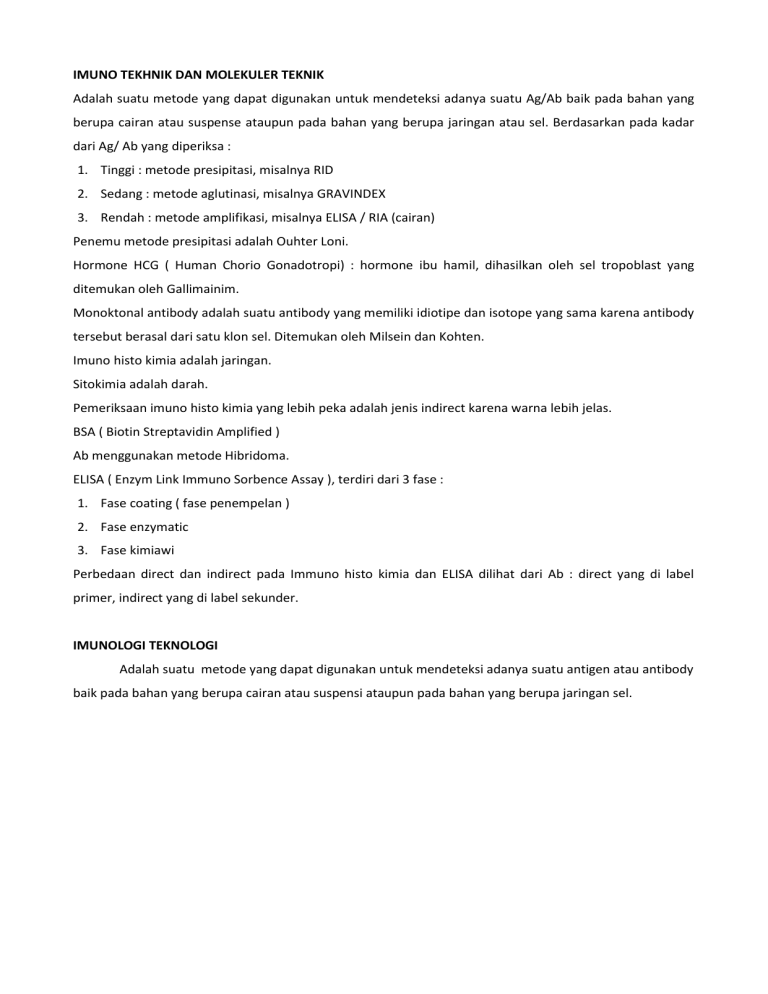
IMUNO TEKHNIK DAN MOLEKULER TEKNIK Adalah suatu metode yang dapat digunakan untuk mendeteksi adanya suatu Ag/Ab baik pada bahan yang berupa cairan atau suspense ataupun pada bahan yang berupa jaringan atau sel. Berdasarkan pada kadar dari Ag/ Ab yang diperiksa : 1. Tinggi : metode presipitasi, misalnya RID 2. Sedang : metode aglutinasi, misalnya GRAVINDEX 3. Rendah : metode amplifikasi, misalnya ELISA / RIA (cairan) Penemu metode presipitasi adalah Ouhter Loni. Hormone HCG ( Human Chorio Gonadotropi) : hormone ibu hamil, dihasilkan oleh sel tropoblast yang ditemukan oleh Gallimainim. Monoktonal antibody adalah suatu antibody yang memiliki idiotipe dan isotope yang sama karena antibody tersebut berasal dari satu klon sel. Ditemukan oleh Milsein dan Kohten. Imuno histo kimia adalah jaringan. Sitokimia adalah darah. Pemeriksaan imuno histo kimia yang lebih peka adalah jenis indirect karena warna lebih jelas. BSA ( Biotin Streptavidin Amplified ) Ab menggunakan metode Hibridoma. ELISA ( Enzym Link Immuno Sorbence Assay ), terdiri dari 3 fase : 1. Fase coating ( fase penempelan ) 2. Fase enzymatic 3. Fase kimiawi Perbedaan direct dan indirect pada Immuno histo kimia dan ELISA dilihat dari Ab : direct yang di label primer, indirect yang di label sekunder. IMUNOLOGI TEKNOLOGI Adalah suatu metode yang dapat digunakan untuk mendeteksi adanya suatu antigen atau antibody baik pada bahan yang berupa cairan atau suspensi ataupun pada bahan yang berupa jaringan sel. Untuk pemeriksaan bahan yang berupa cairan atau suspensi Berdasarkan pada kadar antigen atau antibody yang diperiksa Tinggi Sedang Rendah Metode presipitasi metode agutinasi metode amplikasi Misal : RID misal : gravindex IHC ELISA/Ria (jaringan) (cairan) Percobaan dengan menggunakan nutrien agar : Presipitalsi adalah suatu garis yang timbul akibat adanya ikatan antara antigen dan antibodi yang spesifik. HCG dihasilkan oleh sel troploblast HCG pertama kali ditemukan oleh Gallimainin dengan menggunakan metode katak. Katak yang digunakan dari golongan bufalo mehanusticum jenis jantan. Dibawah jaringan kulit dari bufalo mehanusticum terdapat resptor yang jika diberi HCG maka, katak akan mengeluarkan spermanya. Dari sinilah Gallimainin menemukan HCG. PERCOBAAN GALLIMAININ Disuntikan urin pagi hari sebanyak 3 cc tepat dibawah kulitnya Katak (bufalo mehanisticum) Setelah satu jam urin ditanamkan ke katak diambil dan dilakukan pemeriksaan laboratorium. Jika ditemukan spermatozoa katak artinya positif hamil dan jika ditemukan katak selanjutnya satu jam kedua tidak ditemukan spermatozoa katak dites lagi sama seperti yang pertama. TEKNOLOGI PEMBUATAN ANTIBODI MONOKLONAL MELALUI HIBRIDOMA Antibodi monoklonal yaitu suatu antibodi yang memiliki idetipe dan isotipe yang sama karena dihasilkan oleh satu klon sel. Untuk keperluan diagnosa diperlukan monoklonal antibodi. Dalam pembuatan antibodi monoklonal sel plasma diambil dan dikembangkan secara infitro sehingga sel plasma tidak dapat bertahan lama. Oleh karena itu, selanjutnya sel plasma didifusikan dengan sel kanker karena mempunyai sifat immortal (hidup terus) dari sinilah terbentuk antibodi monoklonal. Pembuatan monoklonal Antibodi melalui HIBRIDOMA PEMBUATAN MONOKLONAL ANTIBODI MELALUI HIBRIDOMA MONOKLONAL ANTIBODI LIMITING DILUTION PRODUKSI ANTIBODI SEL MIELOMA TELOMERASE ( T ) SEL-B *HGPRT & TK ( H ) *ANTIBODI (A) MATI HIBRIDOMA HAHA .,HTA .,HT .,AT .,TT YG TDK MENGANDUNG FAKTOR -T YANG HIDUP HTA., HT., TT 5-FODFORIBOSIL FIROFOSFAT CHO : TETRA HIDROFOLAT FORMIYLGLYCINE AMIDE RIBOTIDE (FGAR) URIDILATE MONOFOSFAT ( UMP ) CH 3 : TETRA HIDROFOLAT MEDIUM SELEKSI HYPOKSANTIN - AMINOPTERIN - TIMIDIN AT., TT INOSINAT MONOFOSFAT ( IMP ) H (+) H (-) TK HGPRT GUANILAT MONOFOSFAT (GMP) MATI HIDUP THYMIDINILATE MONO FOSFAT (TMP ) LIMITING DILUTION HTA ., HT GUANIN TIMIN Untuk memfusikan limfosit B denagn sel kanker digunakan poly Ethylim Glycol yaitu suatu bahan yang dapat menghilangkan kekuatan ion di dalam sel (unlon sel). Limiting Dilition DAN Kultur Hibridoma TEKNIK : LIMITING DILUTION SETIAP SUMURAN DIAMATI PADA MIKROSKOP KULTUR YANG POSITIF DILAKUKAN LIMITING DILUTION KULTUR HIBRIDOMA PRINSIP UJI ELISA SEL ROSET TITER ANTIBODI YANG TINGGI BIAKKAN DALAM SKALA BESAR Limiting dilution dapat dilakukan dengan menggunakan 2 metode : 1. Direct method Misal : Urin mengandung HCG + anti HCG 2. ikatan antigen, antibody, aglutinasi Indrect method Misal : Urin tidak mengandung + latek + YYY + YY ≠ terjadi aglutinasi HCG PERCOBAAN LAIN : Diberi antigen protein dari mans MOUSE Monoclonal yang diproduksi berupa : mouse anti human Mouse Ig digunakan sebagai imunogen Disuntikkan Ig/Ab yang dihasilkan RATUS Berupa Ab sekunder IMUNOHISTOKIMIA Imunohistokimia adalah metoda pewarnaan jaringan yang menggunakan reaksi imunologik dan reaksi kimiawi 1. Reaksi imunologik : ditandai dengan adanya reaksi antara antigen dengan antibodi. 2. Reaksi kimiawi : ditandai dengan adanya reaksi enzymatik yaitu anatara enzym dengan substrat Pada imunohistokimia dikenal ada beberapa metoda antara lain : metode direct, indirect, metoda abc, metoda b-sa. Sebelum melakukan reaksi ini hendaknya diperhatikan terlebih dahulu, dari bahan yang diwarnai. Apabila bahan berupa hasil sayatan yang berasal dari penyayatan dingin, maka segera dapat dilakukan pewarnaan. Bila bahan berasal dari sayatan yang diperoses melalui paraffin, maka harus dilakukan deparaffinisasi sampai pada air. Sebelum dilakukan pewarnaan imunohistokimia, sayatan yang diperoleh baik dari frozen section, maupun dari sayatan paraffin yang telah dilakukan deparaffinisasi, terlebih dahulu harus diberikan peroksida. Tujuannnya adalah untuk menghilangkan endogenus peroksidase, karena enzym ini dapat memberikan reaksi positif palsu. Setelah diberikan peroksida (h202), maka sayatan jaringan tersebut harus direndam dalam larutan trypsin 0,025%. Tujuannya pemberian enzym kadar rendah ini adalah untuk menghilangkan debris protein yang terbentuk, yang kemungkinan debris tersebut menutupi epitop dari bahan yang hendak dideteksi. Oleh karena itu harus dilakukan pada tempratur 37 derajad celcius Selain yang telah dikemukakan di atas, maka untuk membuka epitop yang kemungkinan tertutup oleh suatu debris, agar reaksi antara epitep dengan antibodi yang diberikan dapat berlangsung tanpa hambatan, maka proses tersebut dapat dilakukan dalam microwave. Setelah membicarakan persiapan dari pewarnaan imunohistokimia, sekarang akan dibicarakan prinsip dasar dari masing-masing metoda tersebut A. Reaksi Imunohistokimia Metoda Direct kunci B. IMUNOHISTOKIMIA METODA INDIRECT Tahap 1 Tahap 2 Tahap 3 Tahap 4 C. METODA BS-A (BIOTIN STREPTASVIDIN AMPLIFIED) Tahap 1 Tahap 2 Tahap 3 Tahap 4 Tahap 5 Metoda ini biasanya digunakan untuk pemeriksaan BPH Yang mempengaruhi penggalan struktur sel yaitu Fibroblast Grouth Factor, ini ditemukan pada pasien dgn BPH GEJALA DAN TANDA HIV AIDS CARA PENULARAN HIV : 1. Cairan Tubuh : a. Sekrit mukosa Telah diketahui HIV masuk ke dalam melalui beberapa reseptor seperti CD4 dan CXCR-4 pada monosit-T dan CCR-5 pada monosit. Limfosit- T dan monosit dapat migrasi secara amuboid keluar vaskuler atau ke rongga tubuh. Monosit dapat berubah menjadi makrofag dan Dapat berada pada mukosa b. Darah 2. Intra Uteri 3. Seksual : a. Hetero seksual b. Homo seksual PERJALANAN INFEKSI “HIV” MELALUI TIGA FASE 1. ACUT INFECTION : fase ini terjadi sekitar 2-4 mimggu setelah infeksi, tandanya : panas akut menyerupai flu disebut : acute retroviral syndrome (ars) atau primary hiv infection 2. CLINICAL LATENCY : pada fase ini terjadi replikasi virus dan tidak memberikan gejala pada penderita shg disebut : asymptomatic hiv infection or chronic hiv infection , ini bisa terjadi sekitar 8 tahun atau lebih 3. AIDS : pada fase ini terjadi penurunan cd-4 yaitu berkisar antara 200-250 sel/ cmm, karena terjadi kerusakan sistem imun AIDS Definition: Acquired immune deficiency syndrome or acquired immunodeficiency syndrome (AIDS) is a disease of the human immune system caused by the Human Immunodeficiency Virus (HIV) This condition progressively reduces the effectiveness of the immune system and leaves individuals susceptible to opportunistic infections and tumors. The time between infection and the appearance of symptoms tends to be much longer, allowing more opportunities for these microorganisms to be transmitted to other hosts. The period between infection and the appearance of AIDS can take from 7 to 12 years. AIDS is now a pandemic. In 2007, an estimated 33.2 million people lived with the disease worldwide, and it killed an estimated 2.1 million people, including 330,000 children. History: Genetic research indicates that HIV originated in west-central Africa during the late nineteenth or early twentieth century. AIDS was first recognized by the U.S. Centers for Disease Control and Prevention in 1981 and its cause, HIV, identified in the early 1980s. Pathofisiologi 1. Human beings produce antibodies against specific infections. 2. When HIV infection takes place, anti-HIV antibodies are produced but they do not appear immediately. 3. This is called the “window effect”. 4. In some cases, antibodies to HIV become detectable 4 to 6 weeks after infection. 5. When HIV is in circulation, it invades several types of cells – the lymphocytes, macrophages, the Langerhans cells, and neurons within the CNS. 6. HIV attacks the body’s immune system. 7. The organism attaches to a protein molecule called CD4 which is found in the surface of T4 cells. 8. Once the virus enters the T4, it inserts its genetic materials into the T4 cell’s nucleus taking over the cell to replicate itself. 9. Eventually the T4 cell dies after having been used to replicate HIV. 10. The virus mutates rapidly making it more difficult for the body’s immune system to ‘recognize” the invaders. 11. HIV infection progresses through several stages. 12. The clinical course of HIV infection begins when a person becomes infected with HIV through: sexual contact with infected person injection of infected blood or blood products Perinatal or vertical transmission Signs and Symptoms The symptoms of AIDS are primarily the result of conditions that do not normally develop in individuals with healthy immune systems Most of these conditions are infections caused by bacteria, viruses, fungi and parasites that are normally controlled by the elements of the immune system that HIV damages. A person may remain asymptomatic, feel, and appear healthy for even years even though he or she is infected with HIV. While he or she does not exhibit AIDS, the immune system starts to be impaired. The person may exhibit neurological symptoms such as memory loss, altered gait, depression, sleep disorders or chronic diarrhea. This set of symptoms is often called AIDS-related Complex (ARC) by clinicians. As the symptom progress, the patient becomes an AIDS patient. Minor Signs: 1. Persistent Cough for one month 2. Generalized pruritic dermatitis 3. Recurrent herpes zoster 4. Oropharyngeal candidiasis 5. Chronic disseminated herpes simplex 6. Generalized lymphadenopathy Major Signs: 1. Loss of weight – 10 percent of body weight 2. Chronic diarrhea for more than one month 3. Prolonged fever for one month Common Opportunistic Infections 1. Pneumocystis carinii pneumonia 2. Oral candidiasis 3. Toxoplasmosis of the CNS 4. Chronic diarrhea/wasting syndrome 5. Pulmonary/extra-pulmonary tuberculosis 6. Cancers a. Kaposi’s sarcoma – affects small blood vessels and internal organs b. Cervical dysplasia and cancer. Researchers found out that women with HIV have higher rates of this type of cancer. Cervial carcinoma is associated with Human Papilloma Virus (HPV). c. Non-Hodgkin’s lymphoma – cancerous tumor of the lymph nodes. This is usually a late manifestation of HIV infection. Mode of Transmission: 1. Sexual intercourse 2. Blood transfusion and sharing of infected syringes and needles among intravenous drug users 3. Vertical or perinatal transmission (from a pregnant woman to the fetus during pregnancy, child delivery or breast-feeding) There are several ways of receiving infected blood: 1. Blood transfusion 2. Sharing of unsterilized syringes and needles used for intravenous injections 3. Transmission during pregnancy a. Maybe transplacental b. There is greater risk of transmission when mother has developed advanced AIDS 4. Organ donation 5. Accidental exposure in hospitals or clinics Diagnostic Examination: 1. ELA or ELISA – Enzyme link immunosorbent assay 2. Particle agglutination (PA) test 3. Western blot analysis – confirmatory diagnostic test 4. Immunofluorescent test 5. Radio immuno-precipitation assay (RIPA) Many people are unaware that they are infected with HIV. HIV tests are usually performed on venous blood. Many laboratories use fourth generation screening tests which detect anti-HIV antibody (IgG and IgM) and the HIV p24 antigen. The detection of HIV antibody or antigen in a patient previously known to be negative is evidence of HIV infection. Individuals whose first specimen indicates evidence of HIV infection will have a repeat test on a second blood sample to confirm the results. Treatment Modalities: “AIDS Drugs” are medicines used to treat but not to cure HIV infection. These drugs are sometimes referred to as “anteroviral drugs.” These work by inhibiting the reproduction of the virus. There are two groups of anteroviral drugs: 1. Reverse trancriptase inhibitors – they inhibit the enzyme called reverse transcriptase which is needed to “copy” information for the virus to replicate. These drugs are: a. Zedovudine (ZDV) – Retirvir b. Zalcitabine – Havid c. Stavudine – Zerit d. Lamivudine – Epivir e. Nevirapine – Viramune f. Didanosine – Videx 2. Protease inhibitors. They work by inhibiting the enzyme protease which are needed for the assembly of viral particles. These drugs are: a. Saquinavir – Invarase b. Ritonavir – Norvir c. Indinavir – Crixivan Nursing Management: 1. Health education – The healthcare worker must: a. Know the patient b. Avoid fear tactics c. Avoid judgmental and moralistic messages d. Be consistent and concise e. Use positive statement f. Give practical advice 2. Practice universal/standard precaution a. There is a need for a thorough medical handwashing after every contact with patient and after removing the gown and gloves, and before leaving the room of an AIDS suspect or known AIDS patient. b. Use of universal barrier or Personal Protective Equipment (PPE) e.g., cap, mask, gloves, CD gown, face shield/goggles are very necessary. 3. Prevention a. Care should be taken to avoid accidental pricks from sharp instruments contaminated with potentially infectious materials form AIDS patient. b. Gloves should be worn when handling blood specimens and other body secretions as well as surfaces, materials and objects exposed to them. c. Blood and other specimens should be labeled with special warning “AIDS Precaution”. d. Blood spills should be cleaned immediately using common household disinfectants, like “chlorox”. e. Needles should not be bent after use, but should be disposed into a puncture-resistant container. f. Personal articles like razor or razor blades, toothbrush should not be shared with other members of the family. Razor blades may be disposed in the same manner as needles are disposed. g. Patients with active AIDS should be isolated. The Four Cs in the Management of HIV/AIDS 1. Compliance – giving of information and counseling the client which results to the client’s successful treatment, prevention and recommendation. 2. Counseling/education a. Giving instruction about the treatment b. Disseminating information about the disease c. Providing guidance on how to avoid contracting STD again d. Sharing facts about HIV and AIDS 3. Contact tracing Tracing out and providing treatment or partners 4. Condoms Promoting the use of condom, giving instructions about its use, and giving away available condoms Sources: Handbook of Common Communicable and Infectious Diseases, 2006 Ed http://wikipedia.org http://cdc.gov


